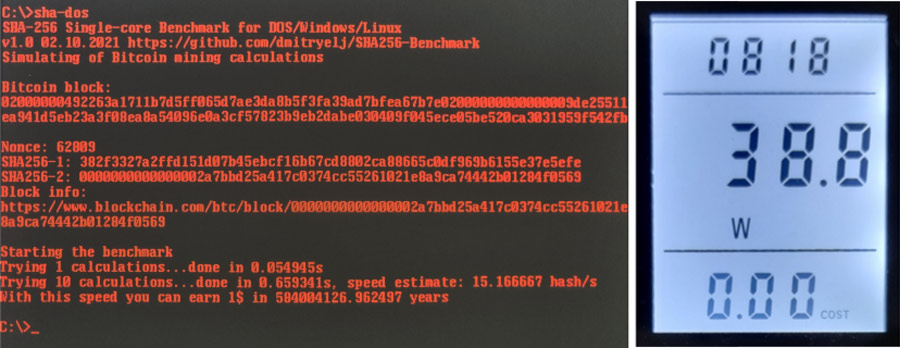386 Bitcoin Miner Laptop Should Earn $1 in 584M Years
Mining on a 16MHz Intel 386SX CPU
Cryptocurrency mining can now be undertaken on a very wide range of devices, from the humble Raspberry Pi 4 to custom mining rigs. But rarely do we see a rig as retro as this. This antique powered mining laptop is provided by retro computing enthusiast Dmitrii Eliuseev, who recently published a blog post explaining how he was using an old Toshiba T3200SX Laptop with a 16MHz Intel 386SX processor (not even a DX!) to mine for Bitcoin. By Eliuseev's own calculations, it will take the Toshiba 584M years to earn $1 in Bitcoin.
Before setting out on his quest to mine Bitcoin on the Toshiba T3200SX, Eliuseev pondered over the wide range of computing devices that have been put to the same money-making purpose. At the top of the pile of Bitcoin mining machines there are specially created ASIC-powered Bitcoin farms, and it has been some time since personal computers and PC components, however powerful, have been of practical use for directly mining BTC. Nevertheless, people have set up Bitcoin mining operations on devices as low-powered as smartphones, or SBCs like the Raspberry Pi — just for fun.
The Toshiba T3200SX dates from 1989, and its launch price of $6,299 ($13,896 in today's money) put it out of reach of most people. It boasted a 16MHz Intel 80386SX CPU, which was cutting edge at the time, especially for a portable/luggable machine.
The lack of available mining software prompted Eliuseev to code his own Bitcoin mining tool based for the SHA256 algorithm. During this process, he kept bumping up against the limits of the 16-bit DOS platform, but with hard work and patience he managed to create his own code, available via GitHub. This code can be compiled on a contemporary Windows machine using the free Open Watcom compiler before being shovelled back onto an old DOS machine like the Toshiba 386SX. Alternatively, interested users can compile the code on a contemporary PC using an MS-DOS compiler like Borland C++, in the DOSBox emulator, before transferring it.
Impressive results, but not in a good way
So, now we arrive at the answer to the big question of how fast this ancient 32-year old 386-powered laptop can mine Bitcoin. The answer is impressive, in the expanse of time it would take to complete enough work to earn a solitary dollar. According to Eliuseev's calculations, it would take the Toshiba 584M years to earn $1 in Bitcoin. That's thanks to a blistering 15 H/s hash rate — yes, hashes per second.
Running the Bitcoin mining task on the old laptop doesn't use too much electricity, relatively. It sucked about 39W when busying itself with the cryptomining task. However, according to a mining profitability calculator we checked, users would be losing approx $3.37 per month running this process, so the prospect of $1 income in nearly 600M years of mining is even more risible.

To put the 386-powered laptop's 15 H/s into proper perspective, it compares favorably against the likes of a Toshiba T1100 Plus model with a 7.1MHz 8086 CPU and 3.6 hashes/s, noted Eliuseev. Looking at something more modern, the retro tinkerer reckons that the tiny Raspberry Pi 4 can achieve "about 200 KH/s" — note that we haven't been able to verify that Raspberry Pi Bitcoin mining performance figure. Back when CPU mining of BTC was all the rage (i.e. up until mid-2011), CPUs like the i7-990X were already over a million times faster than the 80386SX. Today, a top-tier modern ASIC miner like the Bitmain Antminer S19 Pro can achieve 110 TH/s, only about 7 trillion times faster than the old Toshiba laptop.
Further demonstrating the cryptomining on anything/everything trend, in recent days Tom's Hardware has reported on various cryptocurrencies being mined on Tesla Cars, or in background processes on your PC installed by AV software. Someone please figure out how to mine Bitcoin on an old HP calculator like the one I used in high school.
Get Tom's Hardware's best news and in-depth reviews, straight to your inbox.

Mark Tyson is a news editor at Tom's Hardware. He enjoys covering the full breadth of PC tech; from business and semiconductor design to products approaching the edge of reason.
-
InvalidError 3.6H/s for the 8086 vs 15H/s for the 386SX? The 386SX should be much faster than that. Then again, looks like he didn't bother with 32bits mode, which is a huge loss in compute efficiency, memory addressing overhead and register working space. Being stuck at 16bits memory bus width doesn't help either.Reply -
The Art Vandelay "7 trillion times faster than the old Toshiba laptop."Reply
Nobody will ever need that much speed says the guy postulating from the 80s. -
sgtdragon Programmer 8-bit Show And Tell managed to mod his 1 MHz Commodore 64 to mine Bitcoin. This is a remarkable feat for hardware that's close to 40 years old. However, at 0.3 H/s, the system will take nearly a billion years, just to turn a profit of US$10.Reply -
InvalidError Reply
Profit is what you have left after costs. Operating a C64 for a billion years is going to be one heck of a power bill. Then you have all of the maintenance costs over that sort of time span to factor in. You'll be spending millions of dollars just sweeping the dust off of it over that sort of timespan :)sgtdragon said:Programmer 8-bit Show And Tell managed to mod his 1 MHz Commodore 64 to mine Bitcoin. This is a remarkable feat for hardware that's close to 40 years old. However, at 0.3 H/s, the system will take nearly a billion years, just to turn a profit of US$10. -
derekullo So what they are saying is if bitcoin goes to $584 Million a coin tomorrow then they could make $1 in a year?Reply